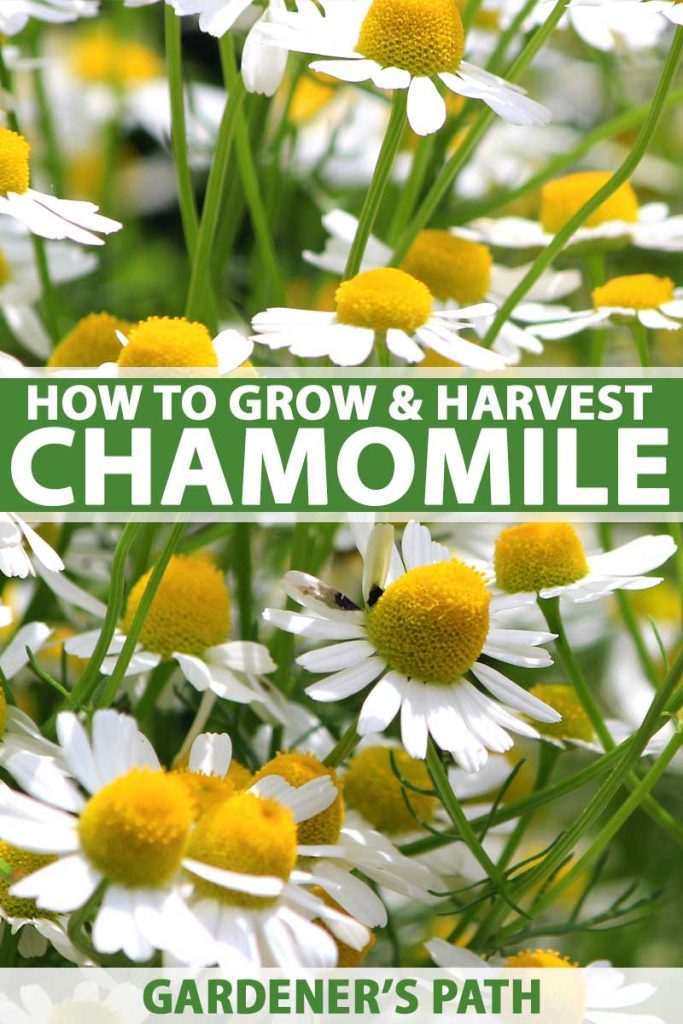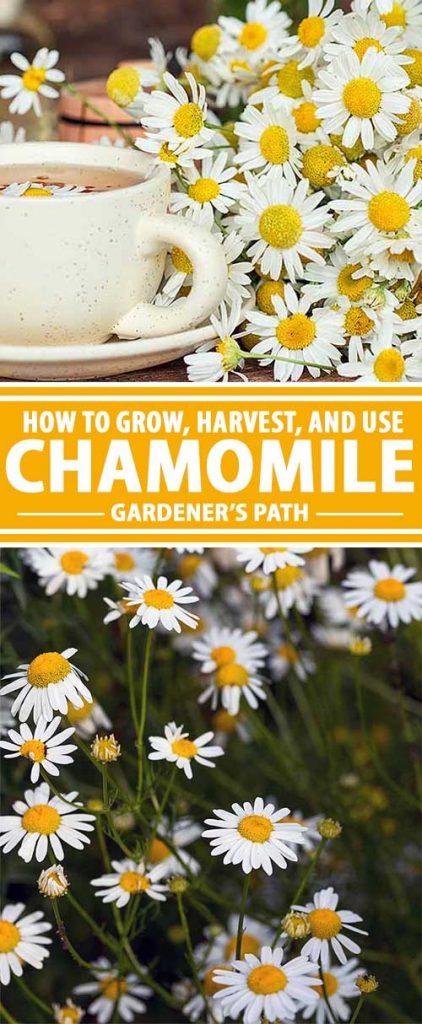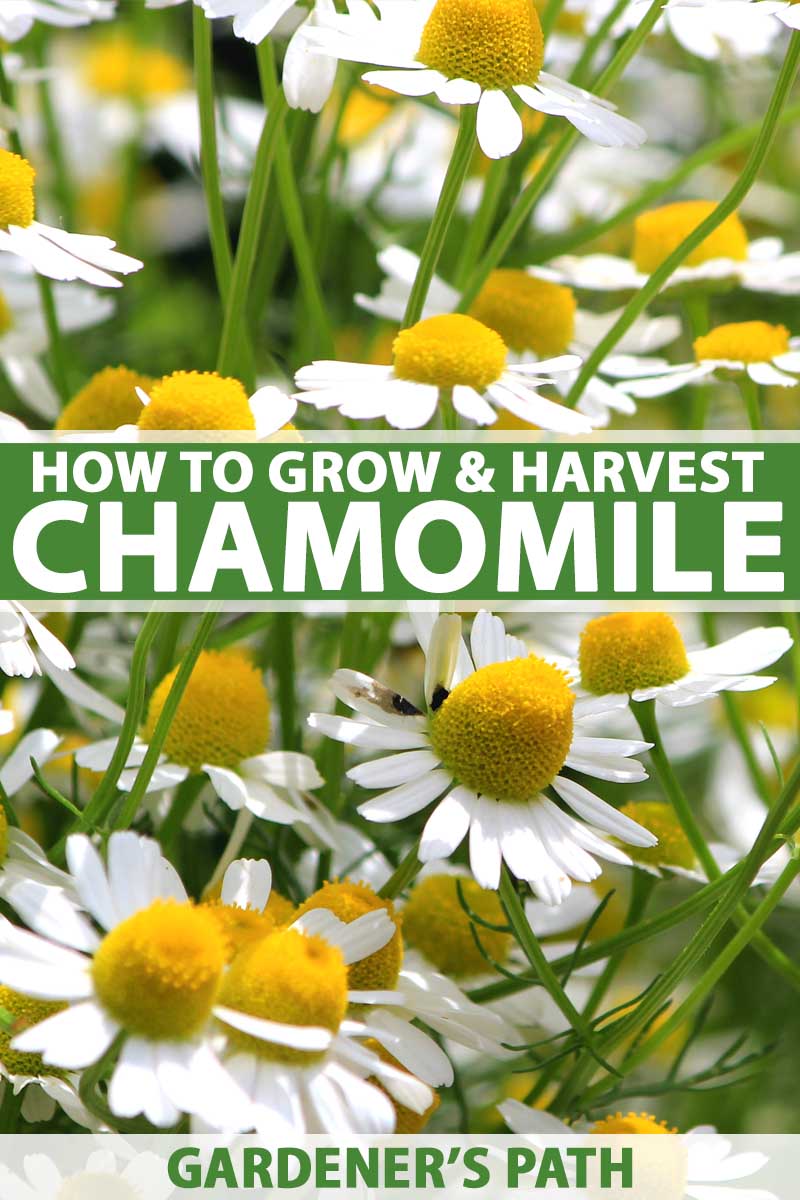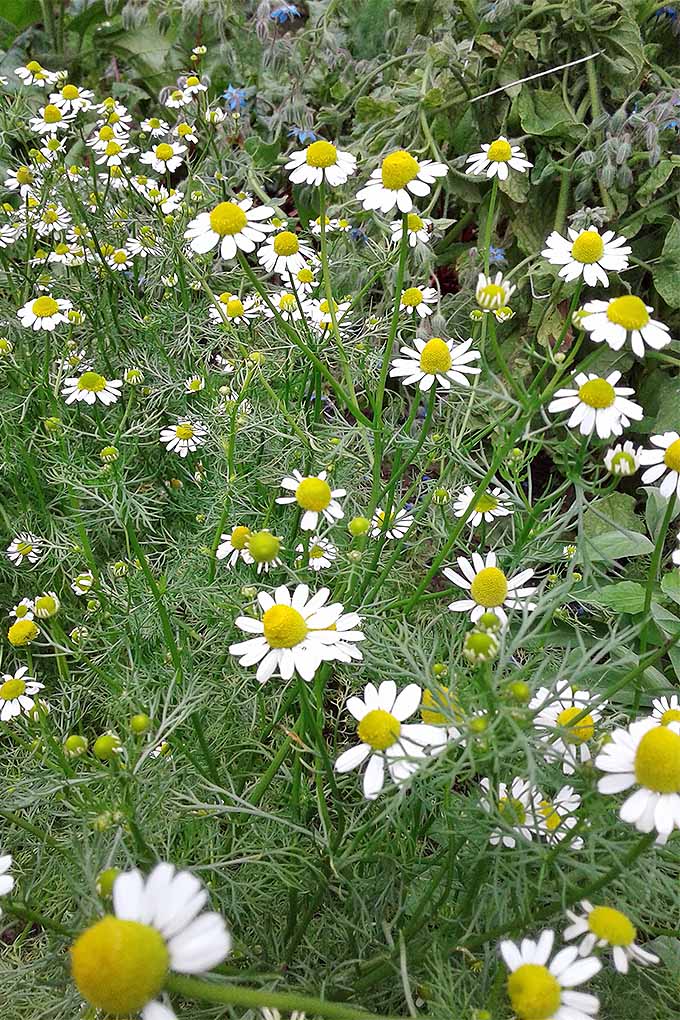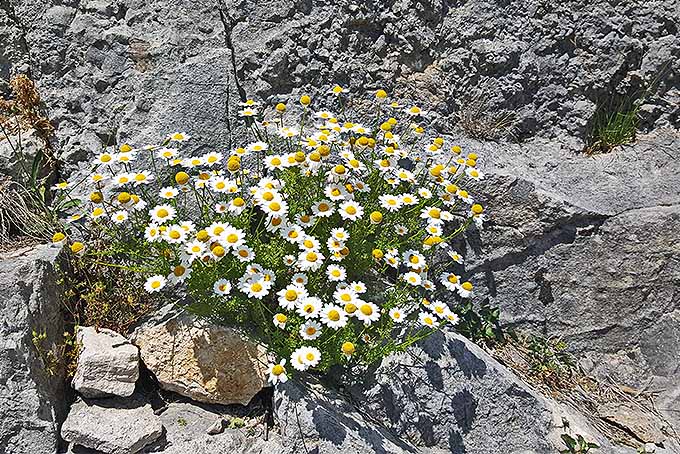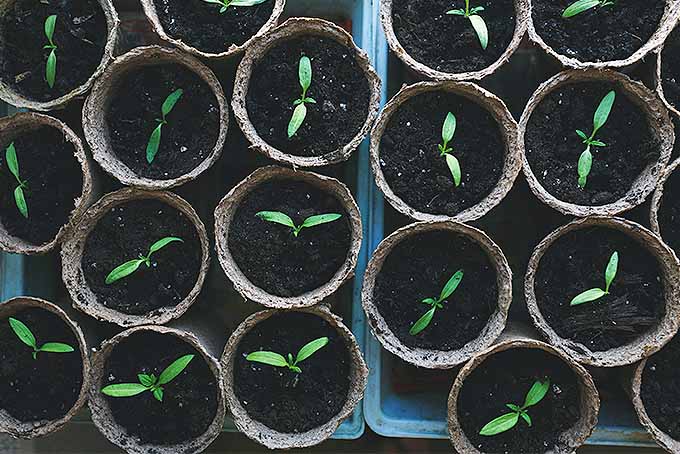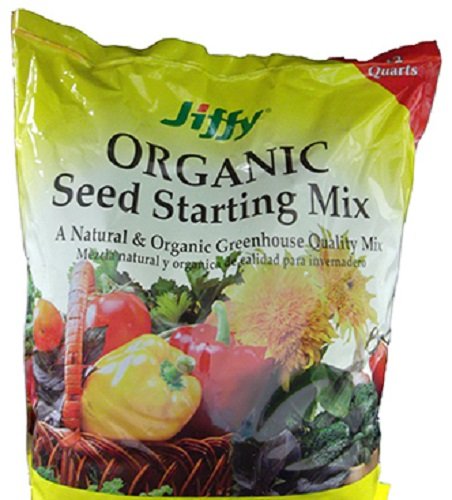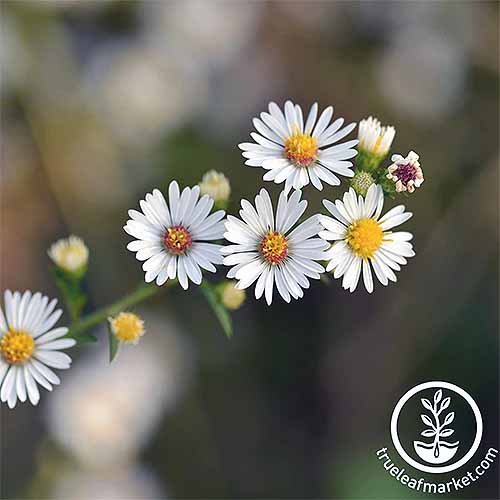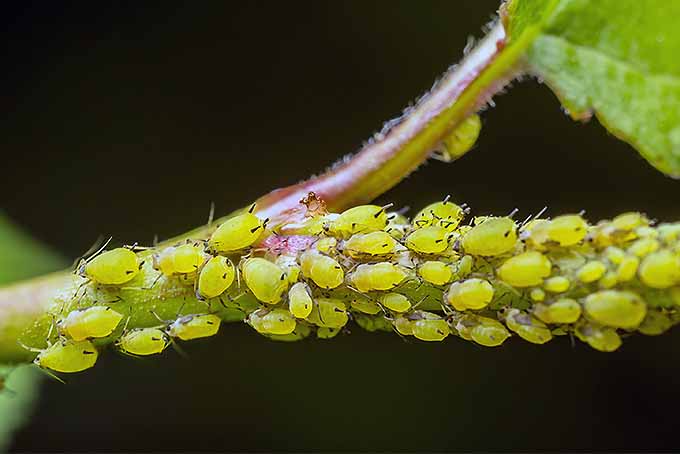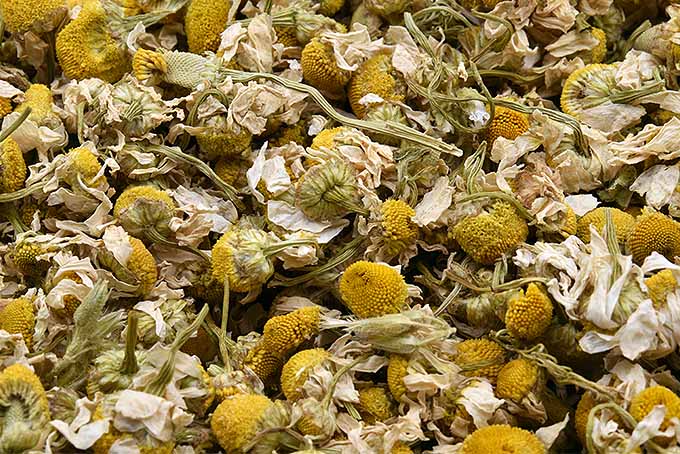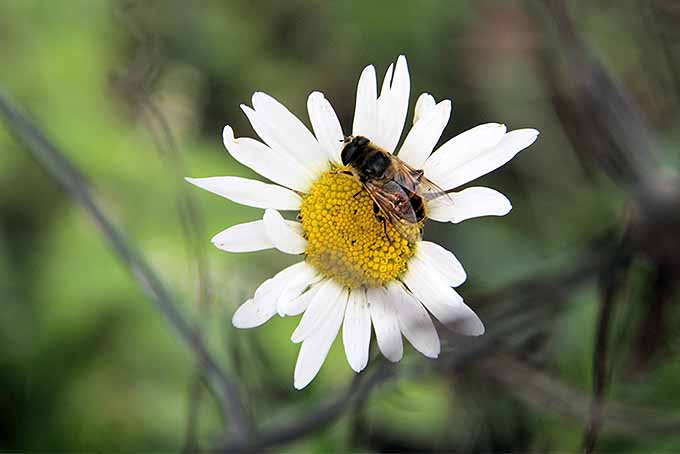I walked into the raised garden beds of a property where I would be working and was delighted by the array of ground cover flowers, prolifically growing vegetables, and leafy herbs. Out of the two dozen or so plants that were growing, one stood above all of the others. A line of beautiful white flowers, two feet tall and smelling like sweet apples, grew between the onions and the cabbage. The soft foliage complemented the starspray flowers that bent over the cabbage heads with a dopey and relaxed abandon. We link to vendors to help you find relevant products. If you buy from one of our links, we may earn a commission. Imagine my joy when I learned that these were chamomile flowers, my favorite tea! I was enthralled and began my journey growing this delightful herb and flower. You’ll find helpful information below about growing and harvesting this dandy flower, mostly what I’ve learned and a few tips and tricks I’ve picked up along the way. And of course, there will be that delightful delve into the history of chamomile and its use around the world. If you have it in the cupboard, now’s the time to heat up a cup of tea with a spoonful of honey!
Historical Cultivation and Use
Commonly known as pinhead, scented mayweed, and (my personal favorite) babuna, the latin name for this delightful flower is Matricaria chamomilla, translating to “water of youth.” It’s a plant native to central and southern Europe, although it has spread far and wide around the globe.
It was used in ancient Greece, Egypt, and Rome as an herbal remedy for ailments ranging from hay fever to menstrual disorders, inflammation, insomnia, muscle spasms, gastrointestinal pain, and rheumatic pain. More popularly, the dried and crushed flowers and leaves have been used to brew a relaxing tea, reputedly with the benefit of aiding a deep sleep and calming stomach pain. It is grown in huge volumes in modern-day Hungary, where the plant is typically exported to Germany for processing.
Varieties of Chamomile
It’s easy to confuse different types of aster with Matricaria chamomilla, but they are very different plants. Although a variety of plants hang onto the coattails of the chamomile name, there are two true species that we’ll be examining today, German chamomile (Matricaria recutita) and Roman chamomile (Chamaemelum nobile).
German
An annual plant that grows well in USDA Hardiness Zones 4-9, M. chamomilla is the plant of choice for those interested in tall-growing flowers. This variety of scented mayweed is often cultivated for its essential oils, and the aromatic flowers that go into that teabag you’re hopefully enjoying while reading this. It reaches about two feet in height and, although an annual, is an aggressive self-seeder – so much so that you might confuse it for a perennial!
The quality of light and temperature provided are more important than the state of the soil. This is partly due to the nature of the roots of chamomile – they are shallow and just barely grip onto the top soil. That also makes M. chamomilla more sensitive to water conditions during the initial stages of growth when the plant is establishing itself. Once it has taken root in your garden, this mayweed is drought tolerant. It typically prefers to receive about one inch of rain a week. If you don’t have one, pick up a rain gauge so you can measure that free watering from ol’ Mother Nature, so your own hose and sprinkler may be used effectively only a supplement. M. chamomilla can be tricky to understand. Although it will grow in almost any soil condition, it will become top-heavy and floppy if the soil is too poor. If your plant ends up leaning over like a sailor sick at sea, you can stake it up with bamboo stakes and garden twine.
Roman
Unlike its German cousin, the Roman variety C. nobile is a low-growing perennial. It spreads via rhizome and will eagerly take control of a small area if left to its own devices. This is an ideal plant to use as a permanent ground cover or lawn replacement.
Although its flowers and leaves are suitable for harvest, the plant is typically grown instead for its benefits as a ground cover. It works very well as an accent plant in containers, or as an effective living mulch to minimize weed growth in between planted rows of vegetables. If used as an actual ground cover, it can tolerate light foot traffic. It produces fewer blooms than the German variety, but has potential uses beyond what its tall-growing cousin provides. All varieties, however, share a few traits in common.
Light Conditions, Companion Plants, and Soil Quality
They prefer full sun but will tolerate partial sun conditions. Babuna will not fare well when temperatures are above 100 degrees fahrenheit (who does?!), and all varieties will compliment certain plants in your garden. Plant M. chamomilla next to onions, cabbage, and mint as companion plants. Both the upright German and low-growing Roman types act as effective ground covers to minimize the development of weeds; as an added bonus, it’s a ground cover that offers tasty flowers! All varieties do well in containers because ideal planter conditions are so close to perfect conditions: well-drained soil that is regularly watered. The low-growing Roman acts well as an accent plant while the German variety is best put into a large container where it can spread out and grow freely. The naturally strong scent of chamomile offers resistance to many insects, and that benefit is extended to other plants growing near it.
Fertilization and Seed Propagation
If growing from seed, prepare for a fun time. It’s important to note right off the bat that transplants work far more efficiently than directly sown seeds.
Growing your chamomile seeds indoors prior to popping them into the ground is the most effective, trusted method for growth. Chamomile specifically enjoys being placed in a sunny window, but will grow under grow lights; make sure to give the seedlings no more than 16 hours of light a day. They require a full 8 hours of “rest” from light. Like most seeds, it’s ideal to plant a small group in each cell of a seed tray. When the seedlings reach a height of 1 to 2 inches, cut back the weakest plants so that the strongest seedling alone remains in the cell. Use fluorescent lights, because incandescent lighting can be too intense for young seedlings. If you place your seeds in natural light (like I do), make sure to rotate them every few days so they do not grow too far in one direction. Fertilize seedlings when they are about 3 months old, but only use half of the recommended amount that your preferred fertilizer suggests on the label. One of the reasons I love chamomile is that it is a plant that seems to thrive on neglect. That predilection for being left alone means it has little need for fertilizer.
Pests and Other Problems
Although M. chamomilla is relatively carefree and tough, it attracts pests and suffers from diseases like any other plant. However, as with most plant diseases and pests, proper care and attention to watering minimizes any of these potential headaches you could encounter. Roman Chamomile Seeds If you’re going to grow your chamomile from seed, it’s always best to buy from a reputable vendor. You can find Roman chamomile available from True Leaf Market in 1/4-ounce, 1-ounce, and 4-ounce packages. And bags of German chamomile seeds in 500 milligram, 1 ounce, 4 ounce, and 1 pound sizes are available from True Leaf as well.
German Chamomile Seeds Once transplanted, chamomile still doesn’t need much of a boost in the fertilizer department. It responds best to a springtime treatment and intermittent feeding during the growing season. Fertilizers higher in nitrogen are more beneficial; chamomile’s weak root system has little use for phosphorus in its development. Right off the bat, if you have an allergy to ragweed or chrysanthemums, it is important to note that you could also be sensitive to chamomile. Powdery mildew is the most common problem with scented mayweed, but it is a concern only when the weather is hot and damp for prolonged periods of time. Aphids, thrips, and mealybugs can bother M. chamomilla as well, but the plant is generally pest and problem free. It can even be processed and turned into an effective spray to aid your other garden plants. Make a batch of tea at triple or quadruple strength, allow it to steep overnight, and use it the next day as an herbicide and aid against mildew.
Harvesting and Herbal Tea
Ah, the long awaited feature on the best part of growing chamomile. As noted above, the German variety of scented mayweed is more suitable for harvesting for tea. The leaves tend to be more bitter, so stick to the flowers for tea. You can simply pluck off the flower heads when you’re ready for them.
The ideal time to harvest is when the flower petals begin to curl downward, instead of growing out straight as they ordinarily do. Although I’ve always allowed my flower heads to dry before using them in a tea, fresh flowers work as well. You will just need more of them. If you’re drying the flower heads, separate them and arrange with some breathing room in between on a piece of cheesecloth or a mesh surface. It’s important to store your harvest in a cool, dry place for about a week for it to dry out. I tried using a dehydrator once, and while it worked, I felt like the end product was less than desirable. Find more tips on drying and storing herbs here. When you’re making a cup of tea, you want to measure out two tablespoons of dried flowers per eight-ounce cup. If you are using fresh flowers, double that measurement and use four tablespoons of fresh flowers per eight-ounce cup. Simply add the flowers into the water and allow it to steep for about 5 minutes, then pour the tea over a sieve to separate the flowers from the liquid.
You can adjust the strength of the tea by really cramming those flower heads in there for a stronger flavor, or by adding just a few if you want a milder taste. Consider adding a sprig of mint or a spoonful of honey to modify the taste to your liking. I’m usually not a big tea drinker, but I love chamomile tea. Part of that allure is because of the personal touches I like to add. Try adding a dash of cinnamon to your tea for a punchy flavor. When contending with a cough and sore throat, try adding four ounces of lemon juice to four ounces of chamomile tea with a tablespoon of honey. That’ll soothe your sore throat, and it tastes pretty dang good! The tea is beneficial for relieving the pain of an upset stomach, to relieve stress, and to get a better rest. (Gardening is excellent for stress relief as well!) After the liquid has cooled, you can apply unsweetened tea directly to irritated areas of your skin. Although I’ve never used it for this purpose, you can even rinse your hair with unsweetened tea to bring a nice shine to those locks of yours. Simply brew the tea and strain it through your hair.
Let It Go Wild
One of the hidden benefits to growing M. chamomilla is watching that flower go wild. It’s a vigorous and lively-looking plant that seems to exude measures of happiness and sunshine, even on a cloudy day. It has found its place in many of my plantings, usually tucked away as a complement to wildflowers such as aster, rudbeckia, and soldago.
It seems like everybody is a winner with this lovely white flower, be it the annual German or perennial Roman. Pollinators are enamored with it and the classic yellow-and-white color combination fits just about anywhere. Best of all, it’s easy to grow and freely offers copious amounts of soon-to-be tea. Product photos via Ferry Morse/Jiffy, and True Leaf Market. Uncredited photos: Shutterstock.
